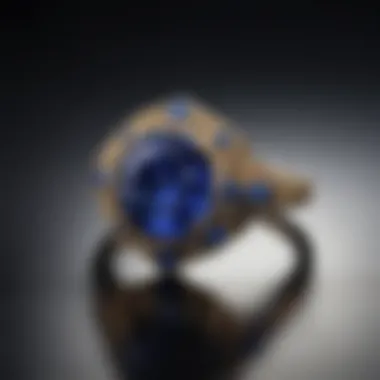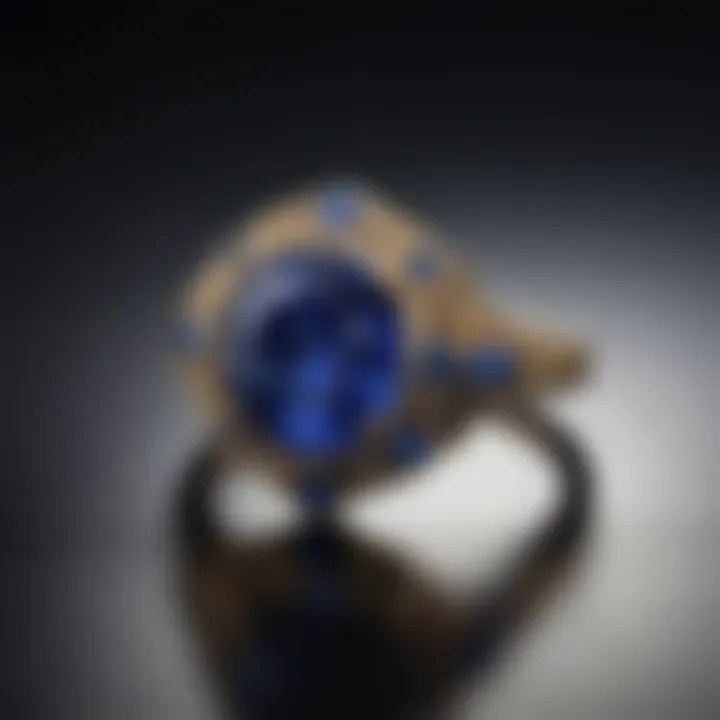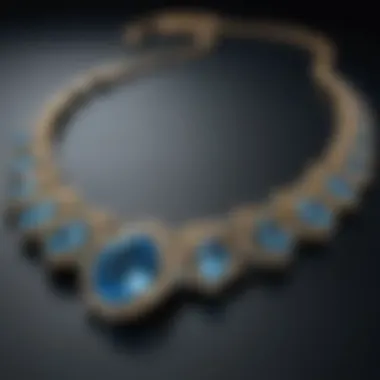Exploring the Allure and Value of Blue Gemstones


Intro
Blue gemstones have captivated humanity for centuries, drawing admiration for their breathtaking hues and intricate properties. From the deep oceanic blues of sapphires to the light sky tones of topaz, these stones evoke a sense of serenity and depth. In this article, we delve into the fascinating world of blue gemstones, exploring what makes them unique and their significance in both history and modern contexts.
Gemstone Overview
Definition of Gemstones
Gemstones are minerals or rocks that have been cut, polished, and used in jewelry or decorative items. These natural formations possess beauty, durability, and rareness. The category of gemstones is broad, encompassing precious stones like diamonds and emeralds, as well as semi-precious ones like turquoise and aquamarine. Various treatments, such as heat or radiation processes, can enhance color and clarity, further contributing to their allure.
Classification of Gemstones
Gemstones can be classified in several ways, but primarily, they fall into two main categories: precious and semi-precious. Precious gemstones, including diamonds, sapphires, rubies, and emeralds, are typically considered more valuable due to their rarity and beauty. Semi-precious stones like lapis lazuli and topaz are often more abundant but equally admired.
Some classifications also consider the physical properties of the stones, such as:
- Hardness: Measured by the Mohs scale, which ranks the scratch resistance of various minerals.
- Color: The hue can impact the stone's market value greatly. A deep blue sapphire is often more sought after than a lighter shade.
- Clarity: Refers to the presence of internal or external flaws. Stones with fewer imperfections are generally more valued.
Historical Significance
Origins of Gemstone Use
The use of gemstones dates back thousands of years. Ancient civilizations revered these stones, not just for their beauty, but for their believed mystical properties. Blue stones, like lapis lazuli, were often associated with royalty, spirituality, and protection. Archaeological discoveries suggest that ancient Egyptians used these stones in amulets and jewelry, attributing powers of healing and wisdom to them.
Cultural Insights: Gemstones in Ancient Civilizations
Throughout history, various cultures have assigned distinct meanings and significance to blue gemstones. In ancient Rome, sapphires symbolized wisdom and nobility. In Hindu culture, blue stones were often linked to divine beings, enhancing their spiritual connotations. The notable cult of the blue sapphire during the Middle Ages established a firm belief in its ability to protect against envy and harm.
Blue gemstones are not just decorative; they are woven into the fabric of history and culture, reflecting human aspirations and emotions.
As we explore the depth of blue gemstones in the following sections, we will elaborate on their characteristics, cultural significance, and current market value, providing a comprehensive resource for both collectors and enthusiasts.
Prelude to Blue Gemstones
The allure of blue gemstones transcends both time and borders. They have captivated individuals for centuries, playing significant roles in various cultures and industries. This section serves as an important introduction to understanding blue gemstones, touching on their unique qualities, rich history, and the fascination they evoke among gemstone enthusiasts and collectors alike. Knowing what defines a blue gemstone and recognizing its historical relevance can enhance appreciation.
Definition and Overview
Blue gemstones are defined by their distinct blue hues, which can range from pale sky blue to deep navy. The color is primarily due to the presence of certain elements such as iron, titanium, and copper within the crystal structure. Common examples of blue gemstones include sapphire, topaz, aquamarine, turquoise, and lapis lazuli.
Their popularity stems from their beauty and rarity. The blue color in gemstones often symbolizes tranquility, loyalty, and wisdom. Each blue gem has its own properties and characteristics that make it unique. This diversity appeals to collectors, jewelers, and investors alike.
Historical Context
Historically, blue gemstones have been highly valued across cultures. For instance, sapphires were regarded as symbols of sophistication in ancient Persia and were often believed to protect their wearers from harm. What is more, turquoise has held sacred status among Native American tribes; it is seen as a talisman of protection and good fortune. Additionally, during the Roman Empire, blue gems were associated with status and wealth, frequently adorning the robes of emperors and nobility.
Throughout history, blue gemstones have also played significant roles in iconography and mythological tales. For example, lapis lazuli was prized in ancient Egypt, often used in burial masks and royal artifacts, representing a connection to the heavens.
"The value of blue gemstones often lies not just in their aesthetic beauty, but also in their rich cultural heritage."
Examining the historical context of blue gemstones allows for a deeper understanding of their current significance. As we explore the various types and properties of these stones in the following sections, their historical importance will provide the foundation for a more profound appreciation. This introduction sets the stage for a comprehensive exploration of the captivating world of blue gemstones.
Types of Blue Gemstones
The area of blue gemstones holds significant importance in this article due to the diversity and beauty of these stones. Each type of blue gemstone offers unique characteristics and qualities that cater to various preferences and purposes. Knowing the different types can help collectors and enthusiasts make informed choices whether for aesthetic, symbolic, or investment purposes. Additionally, understanding the types can guide jewelry designers in selecting the right gems for their creations.
Sapphire: The Classic Choice
Sapphire, a member of the corundum family, is perhaps the most renowned blue gemstone. It is prized for its vibrant blue color, hardness, and brilliance. Sapphires have a Mohs hardness of 9, making them the second hardest gemstone after diamonds.
Historically, sapphires have been associated with royalty and wisdom. These stones symbolize nobility, truth, and loyalty. There are various sources for sapphires, including Sri Lanka, Kashmir, and Madagascar, each producing distinct hues and qualities. The gem can also be found in other colors, but blue sapphires remain the most sought after. Collectors often look for color saturation, clarity, and cut when evaluating sapphires.
Topaz: Beyond the Misty Blue
Topaz is often overlooked but offers its own unique charm. Sky blue topaz, known for its clarity and cool hues, is especially favored by jewelry makers. Unlike sapphires, topaz has a hardness of 8 on the Mohs scale, making it durable but slightly softer.
The origins of blue topaz can be traced to Brazil, among other regions. The gem is also known for its affordability compared to other blue stones, making it a popular choice among those who desire beautiful gemstones without the hefty price tag.
The clarity and brilliance of topaz make it versatile for various designs, whether in casual or formal jewelry.


Aquamarine: A Splash of Serenity
Aquamarine is recognized for its calming blue shades reminiscent of the sea. The name itself comes from the Latin words "aqua" and "marina," meaning "water of the sea". This gemstone represents peace, tranquility, and clarity. Typically more translucent than sapphire, aquamarine can range in color from pale blue to deep blue.
With a Mohs hardness of 7.5 to 8, aquamarine is still quite durable. Its unique color, light reflections, and serene feel make it popular for both rings and pendants, often favored for wedding jewelry.
Turquoise: Earth’s Treasure
Turquoise is one of the oldest gemstones, dating back thousands of years. Its distinctive sky-blue color sets it apart from other blue gemstones. The origin of turquoise is commonly tied to a variety of locations, including Iran, the United States, and China.
Unlike other gemstones, turquoise is relatively porous and softer with a Mohs hardness of 5 to 6. Due to this, caring for turquoise requires extra attention. Traditionally, it has held cultural significance, often seen as a symbol of protection and good fortune in many indigenous cultures.
Lapis Lazuli: The Royal Blue
Lapis lazuli is famous for its deep, celestial blue color, often featuring flecks of gold due to the presence of pyrite. Spanning a Mohs hardness of 5 to 6, this gemstone has been used since ancient times in jewelry and ornamentation. It often carries associations with royalty, wisdom, and spirituality.
Historically found in Afghanistan, lapis lazuli is treasured for its rich color and historical significance. Its deep tones have made it a popular choice for statement pieces in jewelry, appealing to those seeking to make an impression.
Understanding these types of blue gemstones is essential for anyone interested in the world of gems. Each stone carries its unique story and significance, making the exploration of blue gemstones a fascinating journey. The qualities and properties of these gemstones also play a crucial role in their market appeal and value.
Formation and Properties of Blue Gemstones
The section on Formation and Properties of Blue Gemstones is vital for understanding the origin and nature of these exquisite stones. Knowing how a gemstone forms not only enriches the appreciation of its beauty but also informs potential buyers and collectors about its quality and value. Each blue gemstone has its unique formation process that influences its physical properties, including hardness, clarity, and overall appearance. Furthermore, recognizing these properties is essential since they determine not only the gem's aesthetic appeal but also its suitability for various types of jewelry.
Geological Processes
The geological processes involved in the formation of blue gemstones vary significantly. Most blue gemstones form deep within the Earth, where heat and pressure modify raw materials into precious stones over millions of years.
For instance, sapphires and rubies primarily form in metamorphic rocks, originating from corundum, which is a species of aluminum oxide. The presence of specific trace elements during their formation leads to their vivid hues. In contrast, gemstones like turquoise are deposited via aqueous solutions, in which mineral-rich waters flow through rocks, filling cavities and leading to the creation of these unique stones.
In summary, geological processes not only dictate the physical attributes of gemstones but also explain their rarity and market value.
Physical Characteristics
Physical characteristics provide critical insight into distinguishing blue gemstones from one another. Key attributes include hardness, density, luster, and transparency.
For instance, sapphires boast a Mohs hardness of 9, making them one of the hardest materials available for jewelry. This durability contributes to their lasting beauty in designs.
In contrast, stones like aquamarine possess a glassy luster and, with a hardness of 7.5 to 8, strike a balance between beauty and fragility. Turquoise often exhibits a waxy sheen and a distinctive color range that can enhance its appeal but may also require more careful handling to avoid damage.
Through understanding these characteristics, gemstone enthusiasts can make informed choices about which stones are best suited for different kinds of settings and wear.
"The hardness of blue gemstones can vary significantly. It's crucial to understand these differences for care and usage."
Color Variations and Causes
Color variations in blue gemstones arise from several factors, including the presence of trace elements, structural anomalies, and light interactions.
In sapphires, the vivid blue color is often due to the presence of iron and titanium during formation. These elements create complex crystal structures that filter light in such a way that it appears blue.
On the other hand, gemstones like lapis lazuli exhibit a rich blue due to the presence of lazurite, which is a distinct mineral contributing to its color. This variance highlights how the mineral composition can alter the final appearance of the gemstone.
This section on the formation and properties of blue gemstones lays the groundwork for appreciating their unique characteristics, aiding enthusiasts in making informed decisions on acquisition and care.
Cultural Significance of Blue Gemstones
The cultural significance of blue gemstones extends far beyond mere aesthetics. These stones, revered for their beauty, have played integral roles in the narratives of many civilizations around the world. Their deep hues often represent various human ideals, beliefs, and connections with nature. By understanding the cultural importance of these gemstones, one can appreciate not just their physical attributes but also the values they embody in society.
Symbolism Across Cultures
Blue gemstones signify different meanings across various cultures. In many societies, blue is seen as a color of trust and loyalty. For example, sapphires have often been linked to nobility and represent divine favor in Christian tradition. In some Eastern cultures, blue signifies hope and healing, reflecting calmness and serenity. The color blue can symbolize the sky and the ocean, regarded as powerful elements associated with life and eternity.
- Sapphire: Considered a stone of wisdom and royalty, it has been worn by kings and is associated with divine blessings.
- Turquoise: Often linked to protection and good fortune, it has been used as a talisman in various cultures.
- Lapis Lazuli: Revered in ancient Egypt, this stone was believed to provide protection in the afterlife.
These varying interpretations illustrate how blue gemstones resonate with different values, shaping their cultural relevance.
Mythology and Folklore
Mythology surrounding blue gemstones often emphasizes their mystical properties and divine connections. In many myths, they are portrayed as gifts from the gods, endowing their bearers with special powers or protection.


- In Ancient Egyptian mythology, lapis lazuli was associated with the goddess Isis, symbolizing truth and wisdom.
- Greek myths often portray sapphires as a source of protection against envy and harm.
- In Native American cultures, turquoise holds sacred significance, believed to bring strength and healing.
These stories contribute to the allure of blue gemstones, highlighting their role in human imagination as symbols of higher truths.
Uses in Ancient Civilizations
Blue gemstones were not only valued for their beauty but also for their functional roles in ancient societies. They were widely used in crafting jewelry and ornaments, demonstrating wealth and status. Additionally, their significance often transcended the decorative.
- Jewelry and Adornment: Blue gemstones like turquoise were extensively used in jewelry, especially by ancient Egyptians and Mesopotamians.
- Spiritual Practices: In various cultures, blue stones were incorporated into spiritual rituals, believed to enhance intuition and foster peace.
- Trade and Economy: Mining and trade routes for these gemstones were essential for economic development in ancient civilizations, such as the trade of lapis lazuli from Afghanistan to Egypt.
"Blue gemstones were not just ornaments, they were closely tied to cultural identities and economic prosperity."
Conclusively, blue gemstones have played a vital role in shaping cultural identities, symbolisms, and historical narratives. By exploring their significance, one gains insights into human relationships with nature and the beliefs that have evolved over time.
Metaphysical Properties
The exploration of blue gemstones extends beyond their physical beauty and intricate formations. Metaphysical properties play a significant role for many who seek not just aesthetic value, but also deeper meanings and benefits. In this section, we will explore the healing attributes and emotional benefits of blue gemstones. These aspects often attract gem enthusiasts and collectors who believe in the energies that these stones can provide.
Healing Attributes
Blue gemstones are often associated with healing properties that resonate within the physical and spiritual realms. Many users of these gems assert that they can promote physical health and well-being. Each type of blue gemstone has unique qualities.
For example, lapis lazuli is said to enhance immune function and reduce inflammation. Similarly, aquamarine is valued for its calming effects, said to help with stress-related ailments. Moreover, these stones are frequently utilized in meditation practices. The soothing hue is believed to foster tranquility, making them ideal for reducing anxiety. Some popular healing attributes of blue gemstones include:
- Anti-inflammatory Effects: Many believe that certain blue stones can help reduce swelling and pain.
- Throat and Respiratory Support: Stones like turquoise are thought to support throat health and alleviate respiratory issues.
- Emotional and Mental Clarity: Blue gemstones are often linked with enhancing clarity of thought and communication.
"Blue gemstones are not merely for adornment; they are esteemed for their potential to bring balance and healing."
Emotional Benefits
The emotional benefits associated with blue gemstones are another crucial element in their metaphysical properties. These stones are often seen as tools for fostering feelings of peace and emotional stability. Many people turn to blue gemstones in times of emotional upheaval. The color blue itself is frequently connected with calmness and serenity.
Topaz is admired for its ability to help alleviate feelings of sadness or depression, while sapphire is thought to promote a sense of loyalty and sincerity. Each blue gemstone contributes to emotional and spiritual growth in its own manner. Some key emotional benefits include:
- Promoting Calmness: Many users report that blue gems help to create a calming atmosphere.
- Encouraging Self-Expression: Blue stones like aquamarine inspire more effective communication.
- Facilitating Forgiveness: The wearing of blue gemstones is said to help in letting go of grudges and fostering compassion.
Understanding these metaphysical properties can greatly enhance one’s appreciation for blue gemstones. Knowing how they potentially aid healing and foster emotional balance makes these stones more than just beautiful accessories.
Market Value and Rarity
Understanding the market value and rarity of blue gemstones is essential for anyone interested in gemstones, whether for investment or collection purposes. For gemologists and enthusiasts alike, value assessment goes beyond the mere price tag; it encompasses various factors that can influence a stone’s worth and desirability. This section provides a detailed exploration of the nuances behind market value and rarity and offers insights essential for making informed decisions when purchasing blue gemstones.
Factors Affecting Value
Several key elements contribute to the overall market value of blue gemstones. These factors include:
- Quality and Clarity: The clarity of a gemstone plays a crucial role in its value. Gems with fewer inclusions and blemishes are typically valued higher.
- Color Intensity: For blue gemstones, the shade and hue are vital. Sapphires, for example, are often valued for their deep, vivid blue. The richer and more saturated the color, the higher the price may be.
- Size and Carat Weight: Larger gemstones are rarer, and their value increases significantly with size. This is especially true for certain types like tanzanite, which are found in limited quantities.
- Provenance: The origin of the gemstone can also affect its value. For instance, sapphires from Kashmir often carry a premium due to their historical significance and rarity.
- Cut Quality: The way a gemstone is cut can enhance its appearance and therefore its marketability. Well-cut stones reflect light beautifully, increasing their attractiveness and value.
Finding the right balance between these factors is critical when evaluating the investment potential of a blue gemstone. Often, collectors and investors prioritize specific characteristics based on personal preferences or market trends.
Current Market Trends
The market for blue gemstones has seen notable fluctuations, influenced by various economic and cultural factors. Recent trends indicate:
- Increased Demand for Gemstones: Rising interest from younger generations, especially in sustainable sourcing and unique aesthetics, is fueling demand for blue gemstones.
- Focus on Ethical Sourcing: Gemstone buyers are increasingly conscious of the origins of their stones. Ethical sourcing practices are becoming more critical in evaluating value.
- Investment Potential: Various blue gemstones, particularly sapphires and tanzanites, are being recognized as potential investment options. Economic uncertainties prompt investors to seek tangible assets like gemstones.
- Online Sales Growth: With a rise in online marketplaces, accessing blue gemstones has become easier. This has diversified buyer demographics and influenced pricing structures.
"Investment in gemstones can be both a financial strategy and an appreciation of nature’s artistry. The two often go hand in hand."
In summary, comprehending the factors affecting the market value and recognizing current trends are vital for any serious gemstone enthusiast or investor. As the landscape of blue gemstones evolves, staying informed will enable better decisions and greater appreciation for these stunning natural treasures.
Care and Maintenance of Blue Gemstones
Proper care and maintenance of blue gemstones are essential to preserving their beauty and value. Each type of blue gemstone has unique properties. Neglecting these can lead to scratches, dullness, or even damage. This section explores cleaning practices, storage recommendations, and tips to avoid damage.
Cleaning Practices
Cleaning blue gemstones requires attention to detail. First, it is important to understand the specific cleaning method suitable for each type of gemstone.
- Sapphire can generally be cleaned with warm, soapy water and a soft cloth. Avoid harsh chemicals, as they can damage the stone’s surface.
- Aquamarine is also safe with warm water and mild soap. However, one must ensure no excess water gets trapped in the setting.
- Turquoise, being softer, requires gentle handling. A damp cloth or a soft brush is recommended, while abrasive cleaners should be avoided.


Always rinse the gemstone thoroughly and dry it to prevent any residue. Regular cleaning helps to maintain the gemstones’ luster and removes buildup that can dull their appearance.
Storage Recommendations
Storing blue gemstones correctly is as important as cleaning them. To avoid scratching and damage, consider the following recommendations:
- Individual Storage: The best practice is to store each gemstone separately. This prevents them from coming into contact with each other.
- Soft Pouches: Use soft cloth pouches or dedicated gemstone boxes lined with fabric to cushion the stones. This minimizes the risk of scratches.
- Temperature Control: Store gemstones in a cool, dry place. Avoid areas with high humidity, as moisture can damage certain stones, like turquoise. UV light can also fade some blues, so keeping them out of direct sunlight is wise.
By adopting these storage practices, one can greatly extend the life of blue gemstones.
Avoiding Damage
Awareness of potential damage is key to prolonged gemstone health. Here are several strategies to protect blue gemstones:
- Avoid Impact: Be mindful during daily activities. Remove rings or jewelry before engaging in physical labor or sports to avoid accidental impacts.
- Heat and Chemicals: Keep gemstones away from extreme temperatures and chemicals. High heat can cause some stones to crack, while chemicals can erode their surface.
- Routine Inspection: Regularly check settings and clasps to ensure they are secure. Loose settings can allow stones to fall out and get lost.
Protecting the integrity of blue gemstones involves simple habits that can prevent serious damage. A little precaution goes a long way.
Choosing Blue Gemstones for Jewelry
Choosing blue gemstones for jewelry involves more than just aesthetic appeal. This section focuses on various specific elements that give blue gemstones their unique position in jewelry design. The selection process requires a balance of emotional connection, personal style, and understanding of the gemstone's properties. For enthusiasts, collectors, and designers, knowing how to choose and incorporate these gems can enhance both the beauty and emotional significance of the pieces.
Factors to Consider
When selecting blue gemstones for jewelry, several factors play a crucial role:
- Quality of the Stone: Look for clarity, cut, and color intensity. Inclusion and hue can impact beauty and value.
- Durability: Different blue gemstones have varying hardness levels. For instance, sapphires and topaz are more resilient than turquoise. Understanding this affects the intended use in jewelry.
- Shape and Size: Consider how the shape of the gemstone will work with the design of the jewelry. Larger stones might dominate a design, while smaller ones can offer subtlety.
- Personal Meaning: Some choose stones based on their metaphysical properties or historical significance. This may influence personal attraction to a certain type of blue gemstone.
Enhancing Design with Color
Color plays a significant role in jewelry design, especially with blue gemstones. The right shade can evoke emotions and create a desired aesthetic. Here are a few considerations:
- Color Wheel Principles: Knowing how blue interacts with complementary colors allows for more effective designs. For example, pairing blue with yellow or gold can create striking contrasts.
- Layering Colors: Don't hesitate to combine various types of blue stones. Aquamarine with sapphire, for instance, can provide depth and interest, making the jewelry design more appealing.
- Metal Choices: The metal setting can enhance or mute the color of blue gemstones. White gold, yellow gold, and sterling silver each create different visual effects that can complement blue hues.
Setting and Mounting Options
The choice of setting and mounting significantly affects the overall appearance of blue gemstone jewelry. Here are options to consider:
- Prong Settings: This popular choice allows maximum light to touch the stone, enhancing its color and brilliance.
- Bezel Settings: These provide a secure hold but may limit light exposure. They're often ideal for softer stones like turquoise.
- Tension Settings: A modern approach that suspends the gemstone between two ends of the band. This visually isolates the stone and emphasizes its color.
- Halo Settings: Surrounding a blue gemstone with smaller diamonds or other gemstones can amplify its color and make it appear more significant.
Choosing blue gemstones requires thoughtful consideration of multiple factors encompassing personal taste and practicality. It is not merely a task but an opportunity to craft meaningful jewelry that resonates with the wearer. By integrating the right choices in quality, design, and setting, the final product can reflect not only the beauty of the stones but also the emotions they evoke.
Investment Potential of Blue Gemstones
The growing interest in blue gemstones as investment opportunities cannot be overlooked. Investing in these stones is not only about acquiring beauty and rarity. It also encompasses elements of economic resilience, personal enjoyment, and portfolio diversification. As gemstone enthusiasts and collectors recognize the intrinsic value of blue gemstones, understanding their investment potential becomes crucial.
Long-term Value Insights
Blue gemstones have demonstrated historical stability in value, particularly in times of economic uncertainty. For example, sapphires and aquamarines have seen appreciation over the years due to their limited availability and high demand. The market for these gemstones remains robust, driven by cultural significance and ongoing interest in unique pieces of jewelry.
Investing in blue gemstones requires knowledge about quality factors. The four paramount attributes to consider are:
- Color: The intensity and depth of blue can significantly impact value. The finest examples often display a deep, vibrant hue.
- Clarity: Transparency and the absence of inclusions are essential for maximizing value. Clean stones tend to command higher prices.
- Cut: Skilled cutting enhances a stone's brilliance and can elevate its market appeal.
- Carat weight: Larger gemstones are increasingly rare, infusing them with higher value.
Many investors are drawn to pieces that not only have monetary value but also carry aesthetic appeal. As noted by gemstone experts, the market has shifted towards purchasing pieces that tell stories or hold cultural significance.
Risks and Considerations
Investing in blue gemstones is not without its risks. Not every purchase will guarantee returns. Here are several considerations to keep in mind:
- Market fluctuations: The gemstone market can be volatile. Prices can change based on trends, consumer preferences, and economic conditions.
- Authentication: The risk of purchasing counterfeit or treated stones is present. Buyers need to rely on reputable dealers and certifications from recognized gemological laboratories.
- Liquidity: Reselling gemstones can be difficult. While fine gemstones may hold value, finding a buyer willing to pay a good price may take time.
- Storage and maintenance: Proper care is necessary to preserve a gemstone’s beauty and value over time.
Culmination
The conclusion of this article encapsulates the multifaceted nature of blue gemstones, fundamental for various reasons. First and foremost, the diverse types of blue gemstones, such as sapphire, aquamarine, and turquoise, serve not only as decorative items but also as historical artifacts. Their significance stretches across cultures and time, acting as connectors to our past. Understanding this context can help jewelers and collectors make informed choices when selecting stones.
Future Trends in Blue Gemstones
Considering current market dynamics and evolving consumer preferences, future trends in blue gemstones likely showcase a growing interest in sustainability and ethical sourcing. Collectors may prefer gemstones that come from responsible mines, prioritizing environmental impact and human rights. Moreover, lab-grown alternatives may gain traction due to their lower costs and ethical appeal. The demand for unique colors and lesser-known stones will likely increase, as consumers seek personalization in their jewelry.
Some emerging trends include:
- Technological Innovations: Developments in gemstone treatments and enhancements may allow for broader appreciation of lesser-known stones.
- Market Diversification: New sources of blue gemstones will likely emerge as exploration expands in previously untapped regions.
- Sustainable Practices: An emphasis on ethical mining and supply chains will shape consumer preferences moving forward.
Final Thoughts
In summary, blue gemstones command a unique position in both the jewelry market and cultural significance. Their timeless beauty and rich history make them not just items of luxury, but also stories that illustrate human achievement and connection. As patterns shift, adapting to the changing landscape can offer both enthusiasm and challenges. Gemstone enthusiasts, collectors, and investors all stand to benefit from understanding these dynamics as they engage with both traditional and emerging markets. This knowledge, combined with an appreciation for the craftsmanship involved in jewelry design, can elevate one's experience in the world of blue gemstones.



